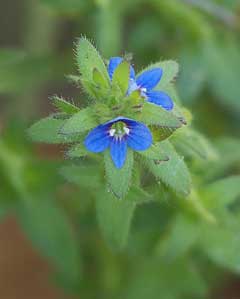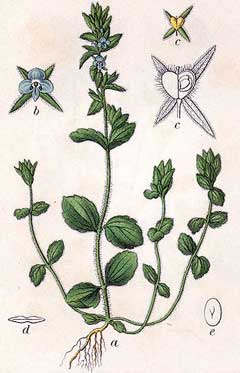 |
|
commons.wikimedia.org/wiki/User:Rasbak |
 |
| commons.wikimedia.org/wiki/File:Veronica_arvensis_Sturm45.jpg |
Translate this page:
Summary
Physical Characteristics

 Veronica arvensis is a ANNUAL growing to 0.2 m (0ft 8in).
Veronica arvensis is a ANNUAL growing to 0.2 m (0ft 8in).
See above for USDA hardiness. It is hardy to UK zone 5. It is in flower from March to October. The species is hermaphrodite (has both male and female organs) and is pollinated by Bees. The plant is self-fertile.
Suitable for: light (sandy), medium (loamy) and heavy (clay) soils and prefers well-drained soil. Suitable pH: mildly acid, neutral and basic (mildly alkaline) soils. It cannot grow in the shade. It prefers dry or moist soil.
UK Hardiness Map
US Hardiness Map
Synonyms
Plant Habitats
Lawn; Meadow;
Edible Uses
References More on Edible Uses
Medicinal Uses
Plants For A Future can not take any responsibility for any adverse effects from the use of plants. Always seek advice from a professional before using a plant medicinally.
Alterative Antiscorbutic Diuretic
The herb is alterative, antiscorbutic and diuretic[240]. It is used in the treatment of scurvy, impurities of the blood etc[240]. It is also used as a remedy for scrofulous affections, especially of the skin, and is bruised and applied externally for healing burns, ulcers, whitlows and the mitigation of painful piles[240].
References More on Medicinal Uses
The Bookshop: Edible Plant Books
Our Latest books on Perennial Plants For Food Forests and Permaculture Gardens in paperback or digital formats.

Edible Tropical Plants
Food Forest Plants for Hotter Conditions: 250+ Plants For Tropical Food Forests & Permaculture Gardens.
More

Edible Temperate Plants
Plants for Your Food Forest: 500 Plants for Temperate Food Forests & Permaculture Gardens.
More

More Books
PFAF have eight books available in paperback and digital formats. Browse the shop for more information.
Shop Now
Other Uses
References More on Other Uses
Cultivation details
Easily grown in a moderately fertile moisture retentive or dry well drained soil[200]. Prefers cool summers[200].
References Carbon Farming Information and Carbon Sequestration Information
Temperature Converter
Type a value in the Celsius field to convert the value to Fahrenheit:
Fahrenheit:
The PFAF Bookshop
Plants For A Future have a number of books available in paperback and digital form. Book titles include Edible Plants, Edible Perennials, Edible Trees,Edible Shrubs, Woodland Gardening, and Temperate Food Forest Plants. Our new book is Food Forest Plants For Hotter Conditions (Tropical and Sub-Tropical).
Shop Now
Plant Propagation
Seed - sow spring or autumn in situ.
Other Names
If available other names are mentioned here
Native Range
TEMPERATE ASIA: Afghanistan, Cyprus, Iran, Iraq, Israel, Jordan, Lebanon, Syria, Turkey (Antalya, Bolu, Bursa, Izmir, Kastamonu, Kayseri, Konya, Mugla, Rize, Samsun, Sivas, Trabzon, Urfa), Russian Federation-Ciscaucasia (Ciscaucasia), Armenia, Azerbaijan, Georgia, Russian Federation (Dagestan), Kazakhstan, Kyrgyzstan, Tajikistan, Turkmenistan, Uzbekistan TROPICAL ASIA: India (northwest), Pakistan EUROPE: Denmark, Finland, United Kingdom, Ireland, Norway, Sweden, Austria, Belgium, Switzerland, Czech Republic, Germany, Hungary, Netherlands, Poland, Slovakia, Russian Federation (European part), Belarus, Estonia, Lithuania, Latvia, Moldova, Ukraine (incl. Krym), Albania, Bulgaria, Greece (incl. Crete), Croatia, Italy (incl. Sardinia, Sicily), Romania, Serbia, Slovenia, Turkey (Edirne, Istanbul), Spain (incl. Baleares), France (incl. Corsica), Portugal AFRICA: Spain (Canarias), Portugal (Madeira Islands), Algeria (north), Morocco, Tunisia
Weed Potential
Right plant wrong place. We are currently updating this section.
Please note that a plant may be invasive in one area but may not in your area so it's worth checking.
Conservation Status
IUCN Red List of Threatened Plants Status :

| Related Plants
|
| Latin Name | Common Name | Habit | Height | Hardiness | Growth | Soil | Shade | Moisture | Edible | Medicinal | Other |
| Veronica agrestis | Field Speedwell, Green field speedwell | Annual | 0.1 |
0-0
| | LMH | N | M | 1 | 1 | 0 |
| Veronica americana | American Brooklime, American speedwell | Perennial | 0.1 |
0-0
| | LMH | SN | WeWa | 2 | 1 | |
| Veronica anagallis-aquatica | Water Speedwell | Perennial | 0.3 |
-
| | LMH | N | WeWa | 2 | 2 | |
| Veronica beccabunga | Brooklime, European speedwell | Perennial | 0.6 |
4-8
| | LMH | SN | WeWa | 1 | 1 | |
| Veronica catenata | | Perennial | 0.0 |
-
| | LMH | N | WeWa | 1 | 0 | |
| Veronica chamaedrys | Germander Speedwell | Perennial | 0.5 |
3-7
| | LMH | SN | M | 1 | 1 | |
| Veronica hederifolia | Ivy-Leaf Speedwell | Annual | 0.5 |
-
| | LMH | N | M | 0 | 1 | |
| Veronica longifolia | Garden Speedwell, Long-Leaf Speedwell | Perennial | 1.0 |
4-10
| M | LMH | N | M | 1 | 0 | |
| Veronica officinalis | Common Speedwell | Perennial | 0.1 |
3-7
| | LMH | SN | DM | 1 | 2 | |
| Veronica peregrina | Necklace Weed, Neckweed, Hairy purslane speedwell | Annual/Biennial | 0.2 |
0-0
| | LMH | N | MWe | 0 | 2 | 0 |
| Veronica polita | Gray field speedwell | Annual | 0.3 |
0-0
| | LMH | N | M | 2 | 1 | |
| Veronica scutellata | Marsh Speedwell, Skullcap speedwell | Perennial | 0.1 |
5-9
| | LMH | N | WeWa | 1 | 0 | |
| Veronica spuria | bastard speedwell | Perennial | 0.5 |
3-7
| | LMH | N | M | 1 | 0 | |
| Veronica undulata | Undulate speedwell | Perennial | 1.0 |
0-0
| | LMH | N | MWe | 1 | 1 | |
| Veronicastrum axillare | | Perennial | 1.8 |
-
| | LMH | N | M | 0 | 2 | |
| Veronicastrum sibiricum | Blackroot | Perennial | 0.8 |
5-9
| | LMH | SN | M | 0 | 2 | |
| Veronicastrum virginicum | Beaumont's Root, Culver's root, Bowman's Root, Culver's Root, Black Root | Perennial | 1.2 |
3-9
| F | LMH | N | M | 0 | 3 | |
|
Growth: S = slow M = medium F = fast. Soil: L = light (sandy) M = medium H = heavy (clay). pH: A = acid N = neutral B = basic (alkaline). Shade: F = full shade S = semi-shade N = no shade. Moisture: D = dry M = Moist We = wet Wa = water.
Now available:
Food Forest Plants for Mediterranean Conditions
350+ Perennial Plants For Mediterranean and Drier Food Forests and Permaculture Gardens.
[Paperback and eBook]
This is the third in Plants For A Future's series of plant guides for food forests tailored to
specific climate zones. Following volumes on temperate and tropical ecosystems, this book focuses
on species suited to Mediterranean conditions—regions with hot, dry summers and cool, wet winters,
often facing the added challenge of climate change.
Read More
Expert comment
Author
L.
Botanical References
17
Links / References
For a list of references used on this page please go here
Readers comment
© 2010, Plants For A Future. Plants For A Future is a charitable company limited by guarantee, registered in England and Wales. Charity No. 1057719, Company No. 3204567.